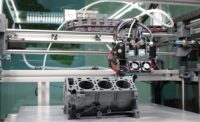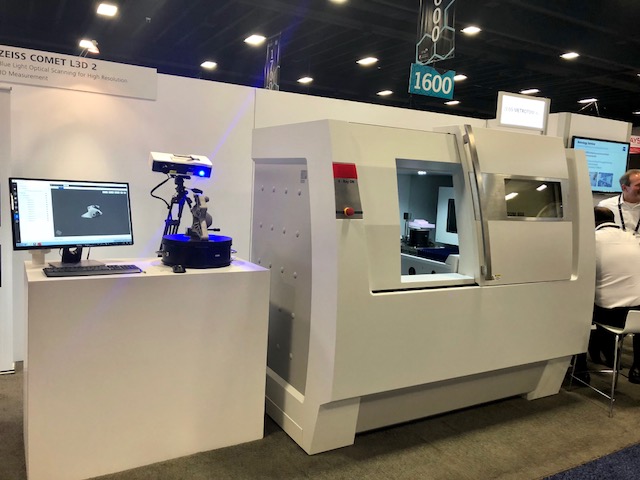QUALITY WEB EXCLUSIVE
RAPID + TCT 2018: Additive Manufacturing Goes Mainstream

The ZEISS METROTOM, an industrial CT system where you can successfully perform measuring and inspection jobs yourself with only one X-ray scan.

The HP booth.

Virtual Surgical Planning (VSP) models at the 3D Systems booth.



Fort Worth, TX — Additive manufacturing (AM) technologies packed the exhibit hall at the Fort Worth Convention Center this week, where the annual RAPID + TCT event attracted more than 6,000 attendees to network and explore the possibilities of 3D printing.
Produced by SME, the four-day expo centered on 3D machines, software, and materials presented by more than 300 exhibiting companies. The event also included more than 150 conference presentations, as well as eight workshops, four keynote presentations, and two networking receptions.
AM in Production
More aerospace, medical, and automotive OEMs are moving from simply prototyping parts to integrating AM technologies into their production lines, and more digital manufacturing companies are expanding their services to guide customers through every step of the process.
Scott Killian, business development manager for aerospace at EOS, says that customers who are proficient in prototyping tend to be more open to the idea of AM platforms in production.
“We see that additive can be one of those pieces that plugs in to the Factory of the Future,” Killian says. “Maybe you’ll have a whole line of different technologies that do different things, but at the end of that line, you get your part.”
EOS is working on automating their AM machines and connecting them digitally as well, says Killian, since Industry 4.0 also necessitates more automated and data-driven production.
“The software side of our business is growing as much as our hardware and engineering side,” Killian says. “We’re looking at various types of automation tools—plug-ins to CAD systems, process monitoring, real-time analytics—all of the things that you really need to build a digital factory.”
Untangling the Digital Thread
The digital thread, a concept that denotes one seamless strand of data from the initial design of a part to the finished product, also came up in many conversations between 3D technology providers and OEMs. Untangling the digital thread has become increasingly important for OEMs looking to optimize their production capability, since the ability to automate complex systems and generate smart data that can be accessed in real time via cloud software can significantly reduce downtime, scrap, tooling, labor, and other production costs.
Phil Reeves, vice president of strategic consulting at Stratasys, says the company’s GrabCAD software is an easy, accessible way for people on the shop floor to get ahold of data. As he puts it, 3D printers should be “problem solvers,” not headache inducers.
“It’s a fantastic idea to put 3D printing on a shop floor, but unless people actually have access to data, it’s not going to do anything,” Reeves said. “And up until now, that has been a barrier.”
Cost-Effective Metals
Stratasys also is developing a strategy around metal 3D printing: a growing and complicated market space that has already enraptured the aerospace and medical sectors.
“It’s no secret that up until now we haven’t had a metal 3D printer, and there’s a reason and rationale behind that,” Reeves says. “We’ve been developing a metal technology, which is based on our proprietary knowledge of jetting, and focusing initially on aluminum.”
There’s a space in the market for aluminum, Reeves says, because it’s used widely—in automotive, aerospace, white goods—but aluminum parts are traditionally made through casting processes, like die casting or powder injection molding, and all of those processes require tools.
“If you look at the existing metal technologies, laser systems really don’t work with aluminum; it’s a very expensive way of making parts from a low-cost material,” Reeves says, “And if you look at the existing powder binder systems, there are questionable metallurgy, shrinkage, and accuracy issues there.”
Cullen Hilkene, CEO of 3Diligent, points out another space in AM that will likely be filled soon: lower cost metal options for automotive parts.
“Metal AM is most heavily oriented around aerospace and medical, and the reason why is not just from a cost standpoint, but also from a performance standpoint,” Hilkene says. He gives the example of company like GE reporting better performance from a jet engine nozzle: that it cut out a bunch of headaches from the fabrication process, reduced weight, and increased the life of the part.
“The economic story is probably not going to be told as soon as the performance story is,” Hilkene continues. “And that’s why the break-in for automotive is in racing—actually being able to get better performance out of these cars by lightweighting them.”
In reality, the incremental return from trying to mass-produce some of the elements in a race car doesn’t lend itself to a mass production role, Hilkene says. At the same time, he does see rapid evolution in this space with lower-cost metal options coming to market.
“The core of [metal AM] is speed and cost,” Hilkene says. “Companies are focusing on that, they’re seeing results from that, and you’re going to see a gradual evolution of more 3D printing for more production applications at higher volumes because of it.”
Product Reveals and Announcements
Stratasys kicked off the event on Monday with a two-hour keynote—also featuring Stratasys customers USA Luge and LAIKA—and three big announcements.
First, Stratasys is bringing to market an enhanced version of their J750 3D printer and a new J735 machine, designed to reduce development cycles and enable engineers and designers to produce more realistic prototypes. They’re also supplemented by a new vivid color package that includes more than 500,000 color combinations, as well as enhanced GrabCAD Print software.
Second, Stratasys is continuing to drive the adoption of AM as a manufacturing tool with the launch of the F900 series of 3D printers. Build on the company’s Fortus 900mc platform, it’s available in three different solutions: the F900, featuring MTConnect-ready interface and production-ready accuracy and repeatability; the F900 Aircraft Interiors Certification Solution (AICS), delivering the performance and traceability required for flight-worthy parts; and the F900 PRO, a production-grade system that is able to produce parts in ULTEM 9085 resin.
Third, Stratasys is beta-testing a new software component, called Jigs and Fixtures for GrabCAD Print, that is designed to simplify and automate print preparation for rapid tooling applications.
Throughout the show, several other companies announced new products and developments:
GE Additive unveiled the Arcam EBM Spectra H, a new metal additive manufacturing system designed to handle high heat and crack prone materials.
EOS launched the EOS P 810 polymer industrial 3D printing platform and HT-23 material for the aerospace, electronics, and mobility industries.
Jabil revealed a cloud-based Additive Manufacturing Network and a strategic partnership with HP to speed digital manufacturing transformations.
3Diligent announced an expansion of its digital manufacturing services to include comprehensive machining and casting alongside 3D printing.
Solvay launched three new high-performance 3D materials and an e-commerce platform.
Ultimaker announced it would be partnering with 10 global material companies to deliver industrial grade engineering plastics.
Vader Systems introduced three new products based on its Magnet-o-Jet liquid metal additive manufacturing technology.
Lulzbot offered a first look of the Lulzbot Mini 2 Desktop 3D Printer.
3D Systems announced that the U.S. Air Force will begin 3D printing replacement parts with 3D Systems' Figure 4 Production System.
Sound Bites for Thought
Killian describes the jump “from prototype to production” for aerospace OEMs. Listen here.
Hilkene lists three variables that he thinks are integral to AM’s continued success. Listen here.
Reeves explains the reasoning behind the Fortus 900mc Aircraft Interiors Certification Solution, which includes specialized hardware and software expressly for 3D printing aircraft parts with highly repeatable mechanical properties. Listen here.
The next RAPID + TCT event will be held May 21-23 at the Cobo Center in Detroit, MI.
Follow Quality on Twitter, Facebook, LinkedIn, and YouTube for the latest manufacturing industry news and quality solutions.
Looking for a reprint of this article?
From high-res PDFs to custom plaques, order your copy today!










